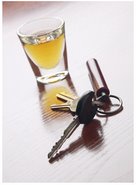Perceptual and Motor Skills, 1994, 79, 99-104. 8 Perceptual and Motor Skills 1994
FIELD SOBRIETY TESTS: ARE THEY DESIGNED FOR FAILURE?'
SPURGEON COLE AND RONALD H. NOWACZYK
Clemson. University
Summary--Field sobriety tests have been used by law enforcement officers to identify alcohol-impaired drivers. Yet in 1981 Tharp. Burns. and Moskowitz found that 32.% of individuals in a laboratory setting who were judged to have an alcohol level above the legal limit actually were below the level. In this study, two groups of seven law enforcement officers each viewed videotapes, of 21 sober individuals performing a variety of field sobriety tests or normal-abilities tests, e.g.. reciting one's address and phone number or walking in a normal manner. Officers judged a
significantly larger number of the individuals as impaired when they performed the field sobriety tests than when they performed the normal-abilities tests. The need to reevaluate the predictive validity of field sobriety tests is discussed.
Field sobriety tests have been used throughout this century by police officers to help them assess whether an individual is too impaired to drive an automobile. A classic paper by Bjerver and Goldberg, (1951) examined the relationship between performance on the field sobriety test and driving. Over the past two decades the National Highway Transportation SafetyAdministration (NHTSA) has funded several studies to examine the effectiveness of field sobriety tests in predicting a person's level of intoxication and driving impairment (e.g., Anderson. Schweitz. & Snyder.
1983; Burns & Moskowitz. 1977; Tharp, Burns, & Moskowitz. 1981).
In a 1977 report, Burns and Moskowitz examined a number of different tests commonly used by officers. Based on the results from a laboratory study, they recommended three tests, the Horizontal Gaze Nystagmus (HGN) test, thewalk-and turn test, and the one leg stand test for further research. The HGN measures the angle of gaze at the onset of jerking movement which can be influenced by alcohol consumption as well as other physiological factors. The other two tests require dividing, attention among mental and physical tasks. Briefly, the walk-and-turn test requires a person to stand on a line in a heel-to-toe position while listening to
instructions and then to take nine steps in a heel-to-toe fashion, pivot, and take nine more steps along a straight line. The one-leg stand requires an individual to stand with arms at the side and extend one foot six inches off the ground and maintain that position while counting for 30 seconds without extending the arms or losing balance.
(For complete instructions see "DWI Detection and
'Requests for reprints can be sent to either author at the Department of Psychology, Clemson University,
Clemson, SC 29634.
The authors thank Ronnie Cole for his assistance in the completion of this study and Jack Davenport for his comments on an earlier draft of this manuscript.
100 S. COLE & R.H. NOWACZYK
Divided Attention Field Sobriety Testing" by NHTSA, 1987.) Although these
tests seemed to hold the most promise, the authors reported that false alarms are a concern. In the 1977 study, 47 percent of the subjects who would have been arrested based on test performance actually had a blood alcohol concentration (BAC) lower than .10 percent, the decision level used by officers.
A 1981 report by Tharp, et al employed the three previously mentioned
tests in another laboratory study. The error rate improved somewhat; 32 percent of the participants judged to have BACs greater than .10 actually had BACs lower than .10, the decision point used in many states for assuming driving impairment. Reliability coefficients for these tests, however, were often below accepted levels for standardized clinical tests. Reliable rests have coefficients of approximately .85 or higher (Rosenthal & Rosnow, 1991). Test-retest reliability coefficients for the field sobriety tests ranged from.61 to .72 for individual tests and .77 for the total test score for 77 individuals who were dosed to the same BAC level on two occasions. Interrater reliability coefficients, based on having
different officers score performance on each occasion,were even lower, ranging from .34 to .60 with .57 as an over-all test score.
Problems in scoring can be attributed, in part, to the lack of standardization across many of the field sobriety test studies. In addition, a few miscues in performance can result in an individual being scored as impaired (Anderson, et at. 1983). For example, a person is viewed as impaired for missing two of nine points on the walk-and-turn test or two of five points on the one-leg stand test. The stringent scoring criteria as well as potential subjectivity in determiningwhether a point should
be awarded may account for accuracy rates that vary from 72 to 96 percent among police agencies using these tests in the Anderson, et al. study. The fact that these tests are largely unfamiliar to most people and not well practiced may make it more difficult for people to perform them. As few as two miscues in performance can result in an individual being classified as impaired because of alcohol consumption when the problem may actually be the result of their unfamiliarity with the rest. This study tested the hypothesis that sober individuals will find the field sobriety tests difficult to perform and, as a result, will be judged to be impaired by officers viewing their performance. Individuals who were completely sober were asked to perform several field sobriety tests and several "normal-abilities" tests which should be well known to individuals. These latter tests included answering personal data questions, such as stating one's address and phone number, as well as walking in a normal manner. Performance on the field sobriety tests and normal-abilities tests was
videotaped.
Subscribe to:
Post Comments (Atom)


No comments:
Post a Comment